
Prepared on Notepad by Ian Smith,
This page created 2nd January 1999, updated 29th March 2000.

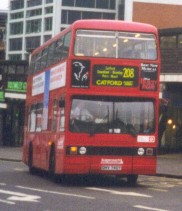
Contents
Nationalisation and Privatisation
London Transport was nationalised by the Conservative Government of Mrs Thatcher in June 1984
in order to wrest it from the control of the Greater London Council.
Privatisation was supposed to follow quickly after,
but the public relations disaster of deregulation in the rest of the country
perhaps made the government think twice before inflicting the raw maw of unbridled competition on the capital.
Instead the new authority, London Regional Transport,
held even tighter control over routes,
and went down the road of enforcing economies through competitive tendering.
The London Transport operating arm became London Buses,
itself divided into a series of operating Districts and then subsidiary companies.
The Districts had to compete with each other - and with independents and newcomers,
to win tender competitions to run LRT's routes, initially in the suburbs and later in the centre too.
The effect was to drive down costs: buses became grubbier,
drivers became harder to find as wages dropped.
Crew operation on everything except the central Routemaster routes rapidly became a thing of the past,
and bus travel consequently became much slower. Fewer people used the buses,
there were more private cars, the speed of travel in London dropped again.
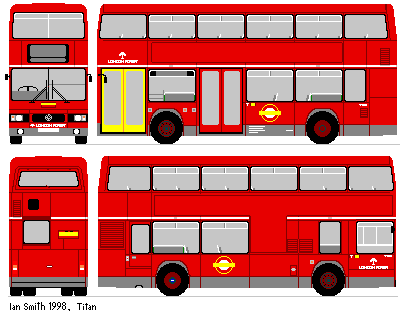 Initially the Titans were well placed in these battles:
low-frequency, filled, large buses with one person operation
was more economical than high frequency operation of small single deckers,
because of fixed wage costs.
The "flip-flaps" were now nearly all turned over to the yellow background
with black:"Pay Driver" legend.
Initially the Titans were well placed in these battles:
low-frequency, filled, large buses with one person operation
was more economical than high frequency operation of small single deckers,
because of fixed wage costs.
The "flip-flaps" were now nearly all turned over to the yellow background
with black:"Pay Driver" legend.
The grey skirt and white band of the London Buses livery suited them well,
too, appearing with the new London Buses roundel from June 1987
Other liveries appeared too,
including the blue and white on the Titans allocated to Bexleybus,
the low-cost unit set up in south-east London. It didn't appear for long.
The unit was an embarassing disaster.
It had won tenders on the basis of reduced staff costs that involved a massive wage cut.
It seems that the compulsorily transferred staff voted with their feet,
and did not turn up to work at the reduced rate.
The failure rate was such that no tenders were won at the next tender round,
and the unit, with its garage, jobs and buses was all lost.
The introduction of minibuses, with drivers on reduced wages,
was another wedge in the door of the new economics of bus operation.
The small buses went places that the large buses couldn't,
and could pay the operators when used on a subsidised service
in a way that hadn't been possible in the old days.
(A fully loaded RF with 2 crew was uneconomical in the sixties!).
But the low wages did not make bus driving much of a job prospect,
and attracting enough staff to keep services reliable has ever since been a major problem,
resulting in frequent changes of operator on many routes
as successive operators fail to reach performance targets.
There was a widespread shift of emphasis
away from the big suburban buses in the early nineties,
and sales of Titans started in 1992.
They found eager buyers in the provinces:
Liverpool soon abounded with second-hand Titans from London
(and Atlanteans from London Country).
Oxford was another significant user.
Privatisation
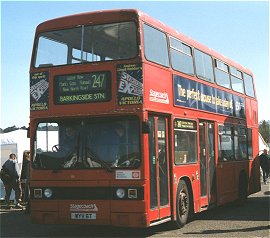 The London Buses companies were mainly privatised in 1994.
Titans were in several fleets:
The London Buses companies were mainly privatised in 1994.
Titans were in several fleets:
Stagecoach East London: the east end was still a Titan stronghold,
despite the massive buildup of Ensign and then Capital Citybus.
Most of the early Titans were concentrated here.
Since buying the company Stagecoach has transferred many Titans
to other companies within its empire.
Notably they have appeared in Scotland,
for Stagecoach A1 Services, and in Cleveland for Stagecoach Transit.
Most of the transferred buses have had the exit door
replaced by a window panel and extra seating.
Early 2000 saw the replacement of nearly all East London's Titans
by new low-floor Trident double deckers (TA class).
The remainder hung on until the autumn of 2001,
when the end came, at least in normal service.
A few, including T1, remain for special duties or training.
T2, a late survivor with Stagecoach East London, is now in preservation.
It appeared in April 2002 at Cobham Open Day.
Stagecoach Selkent, in the Kentish fringes of Greater London,
was a major Titan user, mainly with later Titans.
Some Titans were exchanged with East London,
in connection with the nationwide re-location,
and others transferred to Stagecoach companies along the South Coast.
Early 2000 saw inroads into the Titan fleet at Plumstead and Catford,
with Tridents as replacements. Their demise continued until the end in autumn 2001.
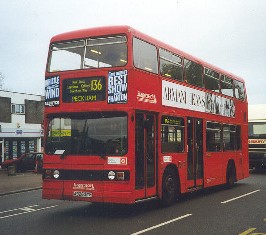
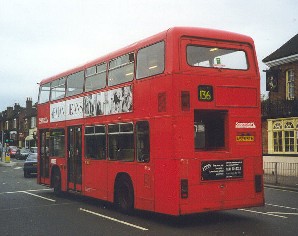
The 136 (Grove Park to Peckham) is the truncated remnant of the once-famous 36B route.
Stagecoach Selkent's T926 passes Grove Park Station in July 1999.
London Central was a major Titan user until early 2000.
Then new low-floor Volvo B7TLs (PVL and AVL classes) flooded in,
and a swathe was cut through the London Central fleet in a matter of weeks.
Apart from its standard fleet of red Titans, with very traditional London Buses style livery, with grey skirt and white band,
London Central has several buses painted in "tramway" style livery for its "Greenwich Clipper" service.
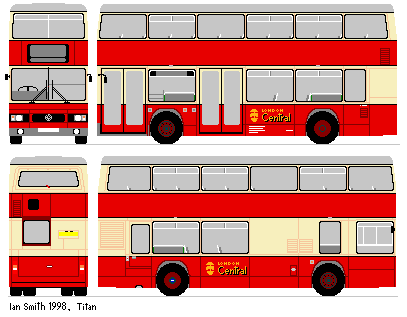
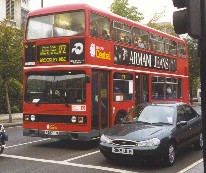
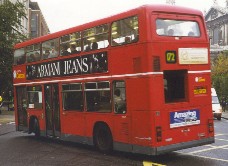
T997 still operates from New Cross, for London Central.
Here in September 1998 it demonstrates the effects of momentum
as it accelerates around the corner east of St Paul's on a southbound 172.
Photo by Ian Smith. Click for larger, much clearer versions.
Leaside Buses had just five Titans at privatisation,
of which three officially went into the County Bus grouping,
and one was officially retained by Leaside Buses.
All received Leaside Travel liveries.
January 2001 saw these three transferred to Arriva (The Original London Sightseeing Tour),
followed by a repaint into TOLST livery.
But at the end of the summer season they passed on to Ensign Bus.
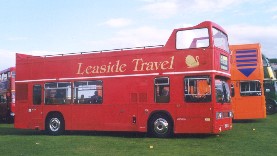
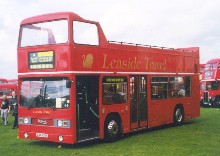
Leaside Travel has converted three Titans to open-top. Apart from special function hires,
they are used on the Lea Valley Leisure Bus operation. T69 was at Showbus 99.
Photos by Ian Smith, Duxford, September 1999.
Click for larger versions.
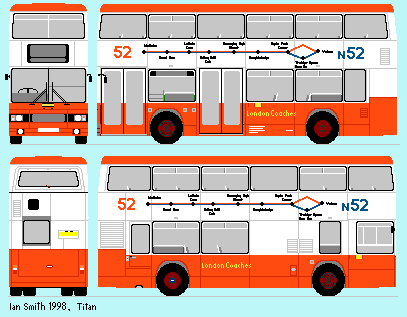 London Coaches had no Titans at privatisation,
but acquired some for their tendered operation of route 52:
(Willesden - Kensal Rise - Ladbroke Grove - Notting Hill Gate - Kensington High Street - Knightsbridge - Hyde Park Corner - Victoria).
London Coaches had no Titans at privatisation,
but acquired some for their tendered operation of route 52:
(Willesden - Kensal Rise - Ladbroke Grove - Notting Hill Gate - Kensington High Street - Knightsbridge - Hyde Park Corner - Victoria).
The buses received a new livery of orangy red and white,
with a route line brand down the sides between the decks
When London Coaches took over Atlas Bus, the 52 was passed over to Atlas to operate,
along with the Titans.
They passed on to Metroline when Atlas was sold off by London Coaches.
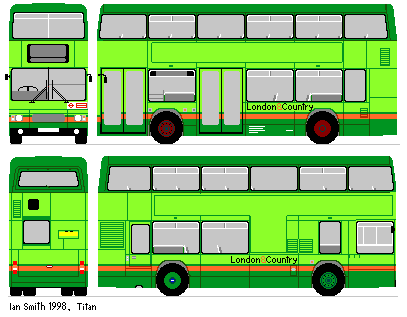 London & Country bought secondhand Titans back in 1992 for their tendered
operations in and around London.
Some were already third-hand, coming from AML of Hounslow.
Routes included the major tourist route 188 (Greenwich - Euston).
They were repainted in the attractive two-tone green with red lining.
L&C reorganised them to their Londonlinks operation in January 1995,
which sold them all in 1996 when routes were retendered.
London & Country bought secondhand Titans back in 1992 for their tendered
operations in and around London.
Some were already third-hand, coming from AML of Hounslow.
Routes included the major tourist route 188 (Greenwich - Euston).
They were repainted in the attractive two-tone green with red lining.
L&C reorganised them to their Londonlinks operation in January 1995,
which sold them all in 1996 when routes were retendered.
London Pride bought some of the London & Country discards,
plus other third-hand examples, for its round-London sightseeing business.
Some were converted to open-top, some to semi-open-top.
They were in an inelegant light red and silver livery,
with tinny dustbin lids on the wheels.
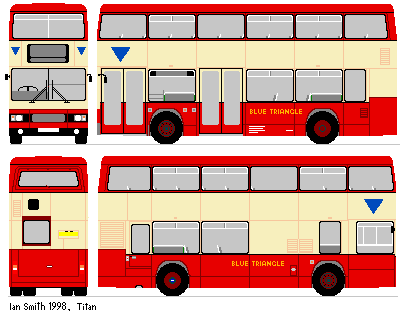 Blue Triangle had three closed-top Titans for their "Official London Sightseeing Tour",
in a nice red and cream livery (with Blue Triangles).
When the sightseeing business was sold to London Coaches the Titans were retained,
and have appeared on contract work such as Railway and Tube substitutions
and on Route 60 during the tender takeover failure in 1999.
Blue Triangle had three closed-top Titans for their "Official London Sightseeing Tour",
in a nice red and cream livery (with Blue Triangles).
When the sightseeing business was sold to London Coaches the Titans were retained,
and have appeared on contract work such as Railway and Tube substitutions
and on Route 60 during the tender takeover failure in 1999.
Blue Triangle acquired several of East London's Titans in the autumn of 2001,
when Stagecoach replaced them, for use on Romford school services.
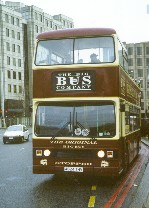
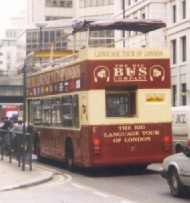
Big Bus Company, another of the tourist operators, operates two kinds of Leyland Titan:
the 1956 MCW variety as well as the modern type, converted to semi-open top.
Some have recently been fitted with convertible canvas roofs, that can be extended in poor weather.
Titans travelled to Berlin for conversion!
T1024 operating on a cold wet winter day (5 December 1998) at Tower Hill.
T722 is one of the canvas-topped convertibles, seen in the City in July 1999.
Photos by Ian Smith. Click for larger versions.
Metroline had no Titans at the start,
but the takeover of Atlas Bus brought in some
which were used on the 52 until replaced by Olympians.
The Titans then formed part of the Metroline Contract Services fleet,
some appearing with other operators on hire.
They were displaced by redundant Metrobuses in mid-1999
and were all sold off to Ensign Bus Sales.
At least one (T302) has since appeared with Priory Coaches on Rail Replacement work.
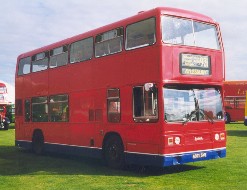
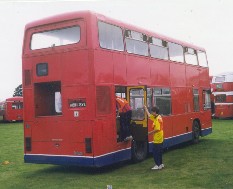
T891 at Showbus 99 shows the Metroline style of mainly red with blue skirt and white cheat line,
but is actually an ex-London Central bus, now in preservation
Photos by Ian Smith, September 1999.
Click for larger versions.
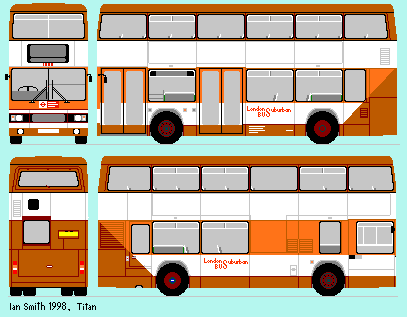
MTL London Northern also had none of its own,
but acquired 35 in rather nice orange / brown / white livery
when it took over London Suburban Buses.
These have since been transferred within the MTL group to Liverpool.
South London had a few Titans at the beginning.
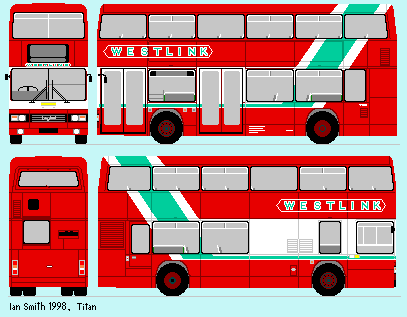
Westlink had thirteen Titans allocated for route 131,
which it carried forward into privatisation,
but they were replaced by London United VA Olympians in 1996.
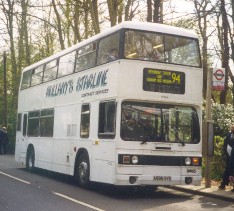
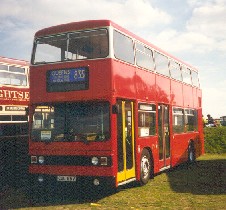
Mullaney's owns T896 and T986, which operate on Watford schools services (eg 937),
as well as appearing regularly at bus shows. T896 is in white
with blue Starline markings.
Mullany's T896 at Cobham Open Day in April 1999,
and Sullivan's T85 at Showbus 97. Click for larger, clearer pictures
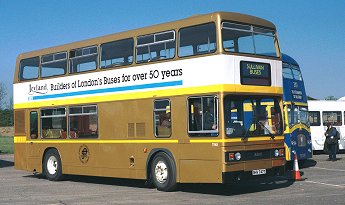 Sullivan Buses of Harrow acquired T85 in 1997, and subsequently another seven Titans,
mainly for Rail Replacement and contract work. Particularly notable in the fleet is T747,
which has been restored to its London Transport Golden Jubilee colours, together with T1983 fleetnumber.
Sullivan Buses of Harrow acquired T85 in 1997, and subsequently another seven Titans,
mainly for Rail Replacement and contract work. Particularly notable in the fleet is T747,
which has been restored to its London Transport Golden Jubilee colours, together with T1983 fleetnumber.
The Imperial Bus Company of Rainham (Essex) is another company that grew on frequent rail replacement services using mainly ex-LT vehicles.
Dedicated route branding is worn T573 for the H1 (Harlow-Loughton) route.
Four Titans are in the 2002 fleet: T214, T302, T379 and T573.
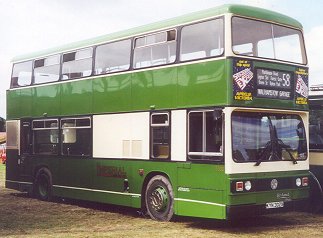
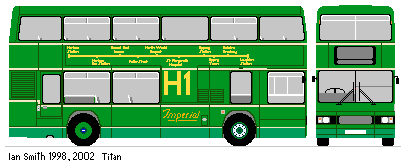
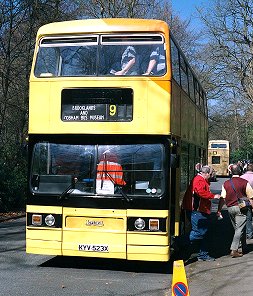 White Rose Travel
White Rose Travel of Thorpe in Surrey was a growing operator in Surrey,
progressing from rail replacement and contracts to tendered services.
"Driven by Quality" was their mission statement,
and the secondhand LT buses that they operated tended to be smartly turned out in red livery
with LT-style trimmings.
Titans were included in their fleet.
White Rose Travel
White Rose Travel of Thorpe in Surrey was a growing operator in Surrey,
progressing from rail replacement and contracts to tendered services.
"Driven by Quality" was their mission statement,
and the secondhand LT buses that they operated tended to be smartly turned out in red livery
with LT-style trimmings.
Titans were included in their fleet.
Unfortunately they were caught up in the financial whirlwind that engulfed several Surrey operators in 2001,
and the company's operations were wound up in February 2002.
T1074 passed on to Sullivan Buses, T576 to Betta-bus in Liverpool, and T968 to Livingstons Dining Services.
Legg's Travel of Weybridge is an emerging operator, taking over some of White Rose's work after their sudden demise.
Three Titan's are used: T305, T361 and T523. The last, at least, is in a striking yellow and orange livery.
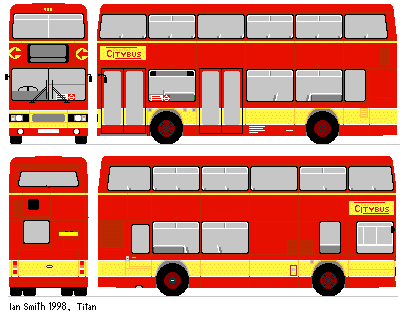
Capital Citybus,
although operating in traditional Titan territory in the East End of London,
has not been a great Titan user. It did however borrow a few early in 1997,
when new Olympians were late arriving for route 91 (Crouch End - Kings Cross - Trafalgar Square).
This route, penetrating into the central zone, was covered by the 80% red rule,
so the borrowed buses appeared in red and yellow, with Capital Citybus numbers.

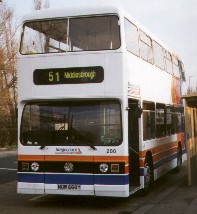
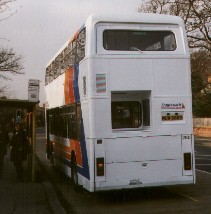
T668 is one of many Titans to make the long trip north from East London to Teesside,
to join the Stagecoach Transit fleet as #280. The centre exit has been replaced by a window panel and seating,
and the livery is, alas, not Cleveland Transit green, yellow and white, but corporate Stagecoach white'n'stripes.
Photos by Ian Smith, Middlesbrough, Dec 1997.
Click for larger versions.

2001
During 2001 the remaining fleets with major London operators dwindled,
as new low-floor buses came in to replace them. A few survived the year with Stagecoach East London as trainers,
and some lingered in service with Selkent at Catford on the 160 and 47 until October.
London Central had mainly ousted them from New Cross, but Bexleyheath, Peckham and Camberwell still put out a few.
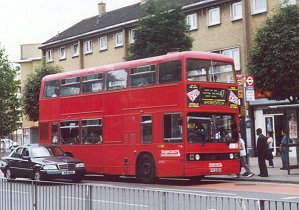
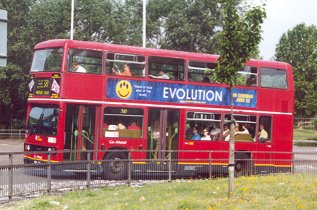
T536 was still on the 47 for Catford garage on 2nd July 2001, passing through Deptford.
T986 was at Rotherhithe, working from Peckham on the 381, also on 2nd July 2001.
2002
March saw the end of normal Titan service on the 229 at Bexleyheath, and from New Cross.
By April London Central's remaining passenger service Titans were concentrated at Peckham and Camberwell. Peckham had T963, 980, 1014 and 1033 in red, plus T172 covered in gold, while Camberwell also had five, T991, 1018, 1000, 1005 and 1102.
The last three, with dot-matrix blinds, had a special role as night bus spares, able to take over on any of the night bus routes if required. Others continue as trainers.
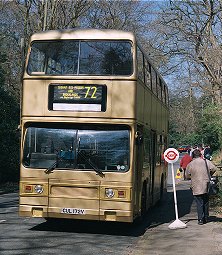
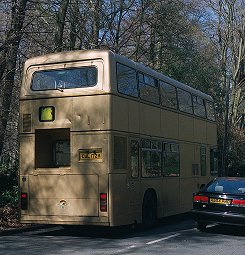
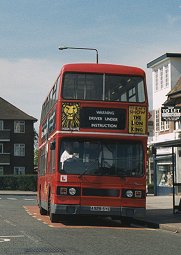
T172, in gold vinyl and paint, was on special duty at Cobham Museum Open Day in April 2002. T982 was driver-training in Mottingham on 29th April 2002.

 Bus Stop Bus Stop
 Part 1. Part 1.
 Part 2. Part 2.
 bus histories. bus histories.
 photo refs. photo refs.
|

